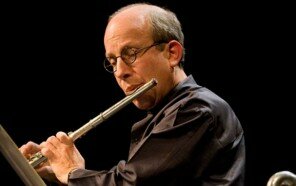What does May Day mean to you? Dancing around the Maypole? Marching for workers rights? Pagan rituals celebrating the return of spring? A troubled ship’s distress call for help? For the past three years, Town Hall’s “May Day! May Day!” concert has asked this question of Seattle composers. This celebration of new Seattle music, curated by local flutist Paul Taub, brought a whirlwind of sounds to Town Hall on Tuesday evening.
In previous years, the “May Day! May Day!” concert spanned an entire day, featuring short performances by a over a dozen local artists and musical groups. This year, Taub switched to a more traditional evening concert format, featuring only three ensembles, each presenting a large-scale work. Performers in Tuesday’s sonic kaleidoscope included the Seattle Modern Orchestra, the Seattle Chamber Players, and up-and-coming composer Aaron Otheim.

Otheim took the stage first to present the world premiere performance of “Bones”, a work written specifically for the May Day concert. A rising star in the local experimental music scene, Otheim’s well-known for his performances with the avant-garde jazz ensemble Speak and for his work a founding member of the Racer Sessions, a weekly music salon held at the University District’s Cafe Racer. Five musicians, all veterans of the Racer Sessions, joined him onstage for Tuesday night’s performance.
Scored for keyboard, piano, alto and tenor saxophone, cello, and double bass, “Bones” is an expansive work full of musical ideas, some composed, some improvised. A veritable grab-bag of sounds, the piece flowed smoothly between complex melodies and moments of pure noise.
As with any work that presents such a wide variety of sounds, some sections were more captivating than others. Exciting at first, the clamorous introduction, which juxtaposes furious bow-scratches from the string with wails from the saxophones, seemed to go on for too long without any development. Other sections layered musical sounds and textures in novel, fascinating ways. I was particularly taken by an intriguing piano-keyboard duet that evoked an image of two lounge pianists playing slightly out-of-sync.
The Seattle Modern Orchestra followed with a performance of John Cage’s “Thirteen”. Cage composed “Thirteen” in 1992, towards the end of his life, as part of a series of “number” pieces — the title of each work signifies the number of instruments to be used.
Instead of a musical score, each piece consists of a set of notes, some “suggestions” on when and what to play, and a couple of ground rules defining how sounds must be made. A stopwatch marks the start and end of the performance. The result is a cloud of sound, hovering somewhere between musical collaboration and random noise-making.
“Thirteen” features a wide variety of instruments, including strings, woodwinds, horns, and a pair of xylophones. With this ensemble, the potential palette of sounds is virtually limitless. The musicians are free to play when they please, resulting in ever-shifting layers and blots of sound.
Over the course of Seattle Modern Orchestra’s performance, “Thirteen” began to feel more like a sonic game or puzzle than a work of music. It was fun to hear how different instruments blended with each other and to guess which of the “suggestions” each musician might be following.
The Seattle Chamber Players wrapped up the evening with Frederic Rzewski’s “Coming Together/Attica”, composed in 1971 in response to the riot and uprising at Attica Prison in New York. This two-part work interweaves melodies and musical textures with spoken excerpts from letters and speeches written by prisoners who witnessed the Attica uprising.
The four members of the Seattle Chamber Players (flutist Paul Taub, clarinetist Laura DeLuca, Mikhail Shmidt on violin, and cellist David Sabee) were joined by four other instrumentalists and a narrator) for their performance of Rzewski’s powerful, historic piece.
In the first part of the work, “Coming Together”, a constant flowing pattern of notes provided a pulsing beat that supported Roger Nelson’s narration. The rhythmic pattern of Nelson’s spoken words took on an instrumental quality of their own, blending in with the musical patterns of the ensemble around him. The second part of the piece, “Attica”, had a melancholy, meditative tone featuring gentle melodies and a blend of spoken and sung words.
Stay tuned for next year’s “May Day! May Day!” concert, when a completely new crop of local music will take Town Hall by storm.